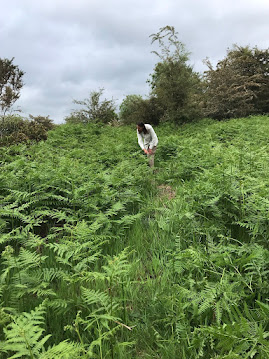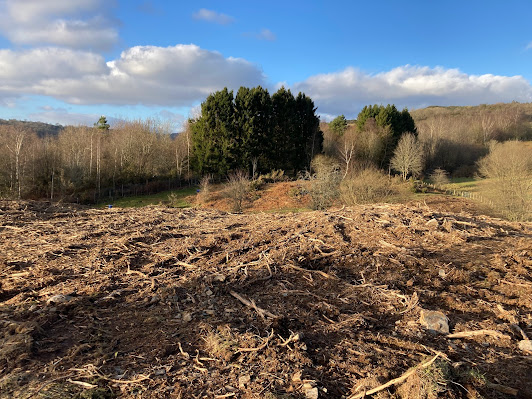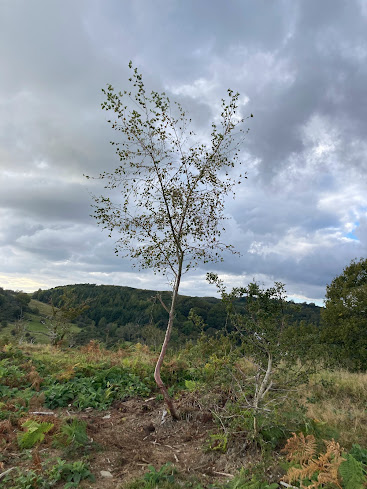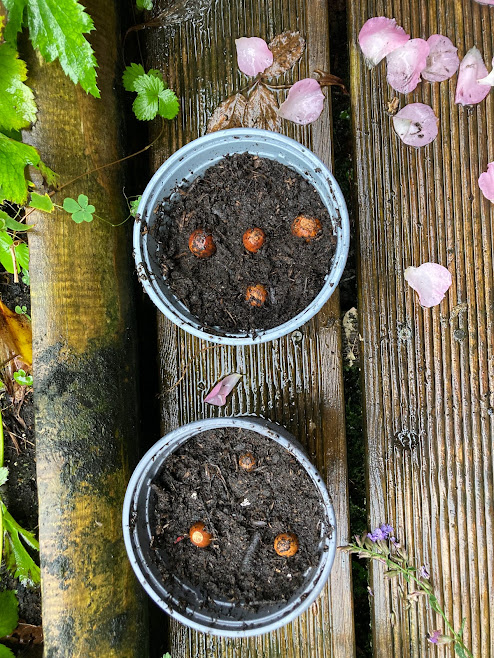Planting plan evolves again
I have worried about the bracken at all stages of knowing this land over the last two years. I remember my first visit, when I just had to launch myself through head high bracken to try and get a sense of the land. I kept the paths and some areas open well in the first year (2021) with the help of friends.
Also the game keeper who ran the pheasant shoot kept the paths open that he needed and was incredibly helpful in clearing areas I knew I would want to plant on.
This year I had less success, losing time when the bracken first appeared due to my broken ankle.
So the aim is to get that canopy up successfully.
With the grant secured I was able to get one mechanical bash away this Summer.
I am conscious that once the saplings are planted this mechanical approach will not be possible as there won't be the space between the plants for machinery. The more ‘standard’ approach to managing bracken is to use weed killer but I have resisted. While it is effective and targeted the run off does pollute the water and that isn’t what this project is about.
I have seen the strength of the growth of new bracken before they unfurl and reach the sunshine. These stems came up over a couple of warm days in spring and you can see there are no unfurled leaves yet to give the root energy and they are at least 15cm tall drawing on energy stored in the rhizome beneath the ground. I will be using mulch mats around the trees and these will act as weed suppressants but even so the strength of these bracken, which look like fists pushing up straight out of the ground, may well push those aside.
The saplings will only be 20cm-30cm when planted. Weakening those rhizomes is essential.
The gorse that was removed in February 2022 was broken up and left on the ground to mulch down into the ground and add nutrients for the saplings when they are planted.
Bracken bashing does work. The theory is that once the bracken is full height in summer, knock it back and the rhizome will push up a second crop while receiving no nutrients from the leaf stock. Repeat this a second time in late summer with the new growth and the rhizome goes into winter depleted and so the new year’s bracken is less vigourous. Repeat 3 years in a row and it becomes manageable.
I visited a site that has a similar bracken problem. They have bashed the bracken once a year with a brash strimmer for 6 years which produced this result:-
In my planting zones there has been some bracken bashing completed over the last 2 summers. The schematic below shows the planting zones by number.
|
Bracken control by planting zone |
Summer 2021 |
Summer 2022 |
Bracken bashing achieved by planned planting time January 2023 |
|
Zone 1: Engulfed with tall bracken |
Mechanically cut x 1 |
Mechanically cut x 1 |
Mature bracken Cut x 1 for 2 years |
|
Zone 2: Gorse no bracken |
No bracken |
Gorse removed February; new bracken mechanically cut x1 |
New bracken Cut x 1 |
|
Zone 3: Engulfed with tall bracken |
Mostly mechanically cut x 1 although some areas not cleared |
Mechanically cut x 1 |
Mature bracken Cut x1 for 2 years (although some areas only cut one year) |
|
Zone 4: Gorse no bracken |
No bracken |
Gorse removed February; new bracken mechanically cut x1 |
New bracken Cut x 1 |
|
Zone 5: Engulfed with tall bracken |
Mostly mechanically cut x 1 although some areas not cleared |
Mechanically cut x 1 |
Mature bracken Cut x1 for 2 years (although some areas only cut one year) |
|
Zone 6: Gorse no bracken |
Covered in gorse, no bracken |
Gorse removed February; new bracken mechanically cut x1 |
New bracken Cut x 1 |
I have considered postponing planting trees by 12 months and to add in 2 mechanical bracken bashes next Summer (2023) and this would be the position:-
|
Bracken control by planting zone |
Plan for Summer 2023 |
Bracken bashing achieved by revised planting time January 2024 |
|
Bracken control by planting zone |
Mechanically cut x 2 |
Mature bracken cut for 3 years |
|
Zone 1: Engulfed with tall bracken |
Mechanically cut x 2 |
Mature bracken cut for 3 years |
|
Zone 2: Gorse no bracken |
Mechanically cut x 2 |
New bracken cut for 2 years |
|
Zone 3: Engulfed with tall bracken |
Mechanically cut x 2 |
Mature bracken for 3 years |
|
Zone 4: Gorse no bracken |
Mechanically cut x 2 |
New bracken cut for 2 years |
|
Zone 5: Engulfed with tall bracken |
Mechanically cut x 2 |
Mature bracken for 3 years |
Clearly postponing for 2 or more years would give even more time for suppressing the bracken but on balance, I think postponing for one year will be sufficient. Once the trees are planted then I will need to continue to manage the bracken by hand - foot or any other means!
While disappointed not to go ahead with planting in January 2023, this feels like a pragmatic way forward with just one year’s delay. The project is to plant a new wood for generations to come, tying up carbon and increasing biodiversity. Giving the saplings the best environment in which to thrive is the right thing to do. Mulch mats, stakes, spiral guards all help as well improved soil from the gorse mulching down more fully and so strengthening the soil. Suppressing bracken, which will be competing above and below ground, will give the saplings a better start in life.
To turn this delay into a positive I am also going to nurture new natural regeneration on the land. This hazel nut sapling is looking strong. I have put brash around it to protect it from predators and can add a stake and spiral so that it gets away.
I am sure there are more and autumn is a good time to locate these and protect them especially now the deer are excluded.
I have harvested some acorns from Cecelia the Sessile Oak and planted 7 spouting acorns at home
Looking at the list of the trees I plan to grow, and from researching what is easy/ simple to propagate (I really am not a gardener but am willing to give it a go!), I will try and nurture hazel nuts and rowan seeds from the wood. I have a crab apple tree at home and I understand that these are easy to propagate so I am going to try a seed tray of those. Also I will find some conkers from the Gilpin Valley and plant those at home. It’s a fun experiment and I may get a dozen or so saplings to plant in Bel’s Wood in a year’s time. If it goes well I can do that every year and replace some of the trees that do not thrive. Maybe I need to establish a tree nursery at the wood. For now I will keep this small and simple and see what the results are.
I feel excited by this turn of events. Lots to do, lots to think about and lots to learn. With the planting plan fully signed off and the grant secured, I can really enjoy the hands on elements of being a woodlander for the next year or so.



























Comments
Post a Comment